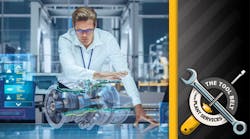Eugene Vogel is a pump and vibration specialist with the Electrical Apparatus Service Association (EASA). Before joining EASA, Eugene operated his own business, General Maintenance Equipment Engineering, Inc., which is a marketing service and training organization for industrial maintenance and related technologies. He also has an extensive background in vibration and dynamic balancing and chaired the St. Louis chapter of the Vibration Institute from 1993 to 2000. Plant Services editor in chief Thomas Wilk and senior content strategist Alexis Gajewski recently spoke with Eugene about how new technologies like IIoT are affecting the industrial motor sector.
PS: I sat in on your session at the EASA annual conference this past June (in 2022), and I found it so compelling that I'm really happy that you're with us today to give us some of the highlights of the content you talked about with the IIoT, motors, and maintenance. Could you start the conversation by telling us a bit about yourself and some of the projects you're working on?
EV: I have a strong background in vibration analysis, and I worked in a service center for 12 years. I started when I was in high school and worked my way through. Education wise, I'm a math teacher. I have a master’s in mathematics education, but I don't let that stop me from having fun. (laughs) I do a lot of different things with EASA as the pump and vibration specialists. I handle questions that come in to me from our members, and I write a number of articles for our own publications and for general industry publications.
PS: You followed up on all your experience this past summer when you gave a presentation on the industrial motor market, especially how the IIoT market is developing. I was intrigued right away because you started with the observation that the goal is not to change the way you wind a stator or repair a bearing; the goal is to produce more useful information at a lower cost, and the new part of all this is how we get the data. I appreciate that because a lot of times our readers may be facing down the IIoT, may be getting a request from management, or may be unsure how what's going on applies to what they do in their job. Could you expand on your ideas about what the new part is and where IIoT is heading?
EV: I'm looking at this from the perspective of our members who are service centers whose main business is repairing machinery in their service center. And, of course, they have field services as well, and among those are predictive maintenance services for their customers. You talk about IIoT and you talk about internet communications and artificial intelligence and someone whose job it is to repair machinery stops and says, “Well, wait a minute. How does this affect me?” And I say, if you're working in the service center repairing machinery, it really does not directly affect the way that you do the repairs to the machine. Now, from a business point of view, it might make a difference as to whether or not you get that machine into your service center to repair it.
Many of our service centers, a majority of our service centers, are involved in some sort of field service with their customers, and among those are machine condition monitoring. This means going into their customer’s facility to measure vibration, measure temperature, measure motor current, find out what's going on with the machines, and produce reports that say, “here's some problem areas you need to look at.” Well, that's a symbiotic relationship between that and repairing the machine in your service center. If you're the provider that's telling them “here’s some problems that need to be addressed,” then you're going to be at the front of the line when that piece of machinery needs to be repaired.
So changes to the landscape in the machine condition monitoring business will affect your relationship with the customer and why you may or may not get that machine for repair. But when the machine comes in, it doesn’t change the way you do the business, it doesn’t change the way you repair that machine.


